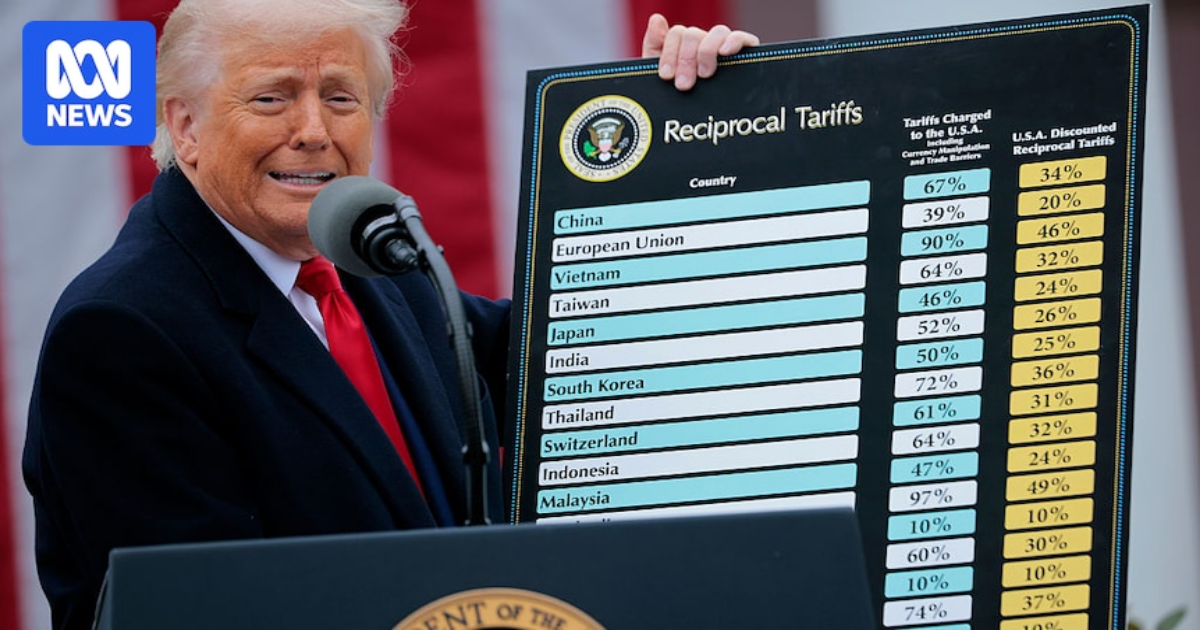Do you think you’re bad at maths? Worry no more.
A child could do the calculation the Trump administration used to generate the huge tariff rates it’s applying to its trading partners.
Try it at home with your family.
Get your calculator
When Donald Trump announced his tariff plan on Thursday, he produced some charts to show the different tariffs he’ll apply to US imports from different countries.
See one of those charts below.
His charts had two columns of numbers.
The first column was titled: “Tariffs charged to the U.S.A. (including currency manipulation and trade barriers).“
It showed the effective tariff rates other countries were supposedly imposing on imports of goods from the United States, using a combination of tariffs and other non-tariff trade barriers (such as biosecurity measures, quotas, and inspections) and currency manipulation.
The second column was titled: “U.S.A. discounted reciprocal tariffs.”
It showed what tariff rates the Trump administration will apply to imports on goods from those countries, in retaliation, to try to level the trade playing field.
But how did Trump come up with the numbers in both columns?
It wasn’t pretty.
This is how he did it.
He claims China is imposing an effective tariff of 67 per cent on imports of US goods.
To calculate that number, go to this link.
When you click on the link it will take you to this table:
It shows the total value of US trade in goods with China in 2024 (in US dollars).
Now, take the total trade balance (295,401.6) and divide it by total value of imports (438,947.4).
That equals 0.67.
Multiply it by 100 and you get 67.29 per cent.
That’s how Trump came up with the number in the first column to “prove” that China is imposing a 67 per cent tariff on US imports.
According to him, since the US only exported US$143.5 billion (A$229.5 billion) worth of goods to China in 2024, but it imported US$438.9 billion in goods from China, China is obviously imposing a 67 per cent tariff on US goods.
How else can you explain why the US would have a goods trade deficit of US$295.4 billion with China?
Next, to get the numbers in the second column on Trump’s chart, do this.
Take the tariff rate that China is apparently imposing on imports of U.S. goods (67.29 per cent) and multiply it by 0.5 (to halve it).
That gives you 33.64 per cent.
That’s how Trump came up with the rate of his “discounted” reciprocal tariff that he’ll apply to China.
He’s saying that, since China is imposing a 67 per cent tariff on US goods imports he’ll have to reciprocate, but he’ll give China a 50 per cent discount.
Do the same exercise for other countries the US has a trading relationship with and that’s how you’ll generate the numbers in both columns on Trump’s fantastical charts.
What about the tariff on Australian goods?
There’s one more thing.
When you’re doing your calculations, if that “trade deficit/imports ratio” with another country is less than 10 per cent, or if the US has a trade surplus with a country, just put a flat tariff (10 per cent) on goods imports from that country.
That’s how Australia got a 10 per cent tariff.
In 2024, Australia was one of the few countries in the world with which the US enjoyed a goods trade surplus, but it didn’t stop Australia getting whacked with one of Trump’s “reciprocal tariffs” anyway.
Mr Trump held up a very big chart of reciprocal tariffs. (Reuters: Carlos Barria)
On Thursday, the Australian economist John Simon, a former head of the Reserve Bank’s economic research department, was disparaging of the whole exercise.
“The US sounds like a Persian carpet salesman with its tariff discounts: ‘US imports were 20 per cent, now half-off at only 10 per cent’,” Mr Simon wrote on LinkedIn.
“I suppose it is meant to be some kind of negotiating tactic. Pretend you’re getting a good deal by putting a “was” price on something that bears no relation to reality.
“Try to create some urgency by saying that if you don’t take the “offer you can’t refuse” it will be more tomorrow.
“But we’re smarter than that right? I mean, we all know that even at 50 per cent off, we’re still getting ripped off if we buy a rug at that price. Don’t we?” he asked.
